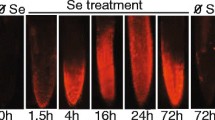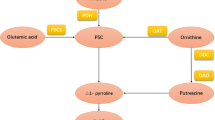Abstract
Broccoli (Brassica oleracea L. var. italica planck) has been highly valued because of its nutrient content, which has been attributed to both sulforaphane, a sulfur-containing compound, and selenium enrichment ability. The sulforaphane synthesis may be affected by Se/S metabolism because sulfate and selenate share the same initial pathway for uptake in plants. Selenocysteine methyltransferase (SMT) plays a critical role in the Se/S metabolism system. In the present work, we analyzed the SMT expression level and sulforaphane content in transgenic broccoli under the conditions of overexpression and RNAi knockdown of SMT under normal and selenium-stressed conditions. The relative expression value of SMT in the overexpression line is 13.93 % higher than that in the untransformed control. Interestingly, the sulforaphane content of the overexpression line was 14.09 % lower after selenium treatment, while that of the empty vector (pCAMBIA1301) transformed and untransformed plants was 59.04 and 66.56 % lower than that of the non-selenium-treated, respectively. In the SMT-RNAi line, which has a relative expression value for SMT 15.60 % lower than that of the untransformed, we cannot detect sulforaphane after selenium treatment. These results showed that SMT plays a key role in sulforaphane synthesis in a selenium-rich environment. Specifically, overexpression of SMT decreases the negative effect of selenium on sulforaphane synthesis, while knockdown of SMT by RNAi enhances the negative effect.





Similar content being viewed by others
Abbreviations
- Amp:
-
Ampicillin
- BA:
-
Benzylaminopurine
- bp:
-
Base pair
- cDNA:
-
Complementary DNA
- cm:
-
Centimeter
- CTAB:
-
Cetyltrimethyl ammonium bromide
- DNA:
-
Deoxyribonucleic acid
- g:
-
Gram
- GUS:
-
Beta-glucuronidase
- HPLC:
-
High-performance liquid chromatography
- Hyg:
-
Hygromycin
- Kan:
-
Kanamycin
- lx:
-
Lux
- MS:
-
Murashige and Skoog
- NAA:
-
Naphthalene acetic acid
- ng:
-
Nanogram
- OD:
-
Optical density
- PCR:
-
Polymerase chain reaction
- Rif:
-
Rifampicin
- RNA:
-
Ribonucleic acid
- SMT:
-
Selenocysteine methyltransferase
- Taq:
-
Thermus aquaticus DNA polymerase
- μL:
-
Microliter
- μm:
-
Micrometer
References
Bonnesen C, Eggleston IM, Hayes JD (2001) Dietary indoles and isothiocyanates that are generated from cruciferous vegetables can both stimulate apoptosis and confer protection against DNA damage in human colon cell lines. Cancer Res 61(8):6120–6130
Fahey JW, Zalcmann AT, Talalay P (2001) The chemical diversity and distribution of glucosinolates and isothiocyanates among plants. Phytochemistry 56(1):5–51
Falk KL, Tokuhisa JG, Gershenzon J (2007) The effect of sulfur nutrition on plant glucosinolate content: physiology and molecular mechanisms. Plant Biol 9(5):573–581
Finley JW, Davis CD, Feng Y (2000) Selenium from high selenium broccoli protects rats from colon cancer. J Nutr 130(9):2384–2389
Hell R (1997) Molecular physiology of plant sulfur metabolism. Planta 202(2):138–148
Huang K, Wu QY, Lin JC, ZHENG JG (2011) Optimization of a plant regeneration protocol for broccoli. Afr J Biotechnol 10(20):4081–4085
Ignacio S, Herna B, Andrea AM (2013) Changes in SeMSC, glucosinolates and sulforaphane levels, and in proteome profile in broccoli (Brassica oleracea var. Italica) fertilized with sodium selenate. Molecules 18:5221–5234
Jefferson RA, Kavanagh TA, Bevan MW (1987) GUS fusions: beta-glucuronidase as a sensitive and versatile gene fusion marker in higher plants. EMBO J 6(13):3901–3907
Li HF, McGrath SP, Zhao FJ (2008) Selenium uptake, translocation and speciation in wheat supplied with selenate or selenite. New Phytol 178(1):92–102
Lyi SM, Heller LI, Rutzke M, Welch RM, Kochian LV, Li L (2005) Molecular and biochemical characterization of the selenocysteine Se-methyltransferase gene and Se-methylselenocysteine synthesis in broccoli. Plant Physiol 138(1):409–420
Moreno DA, Carvajal M, López BC, García VC (2006) Chemical and biological characterisation of nutraceutical compounds of broccoli. J Pharm Biomed Anal 41(5):1508–1522
Nathan VM, John AJ, Elizabeth HJ (2004) Heating decreases epithiospecifier protein activity and increases sulforaphane formation in broccoli. Phytochemistry 65(9):1273–1281
Pilon-Smits EAH, Garifullina GF, Salah AG, Kato SI, Mihara H, Hale KL, Burkhead JL, Esaki N, Kurihara T, Pilon M (2002) Characterization of a NifS-like chloroplast protein from Arabidopsis: implications for its role in sulfur and selenium metabolism. Plant Physiol 130(11):1309–1318
Rausch T, Wachter A (2005) Sulfur metabolism: a versatile platform for launching defence operations. Trends Plant Sci 10(10):503–509
Rayman MP (2012) Selenium and human health. Lancet 379(9822):1256–1268
Robbins RJ, Keck AS, Banuelos G, Finley JW (2005) Cultivation conditions and selenium fertilization alter the phenolic profile, glucosinolate, and sulforaphane content of broccoli. J Med Food 8(2):204–214
Sambrook J, Russell DW (2001) Molecular cloning: a laboratory manual. Cold Spring Harbor Laboratory Press, New York
Sors TG, Ellis DR, Na GN, Lahner B, Lee S, Leustek T, Pickering IJ, Salt DE (2005a) Analysis of sulfur and selenium assimilation in Astragalus plants with varying capacities to accumulate selenium. Plant J 42(6):785–797
Sors TG, Ellis DR, Salt DE (2005b) Selenium uptake, translocation, assimilation and metabolic fate in plants. Photosynth Res 86(3):373–389
Sors TG, Martin CP, Salt DE (2009) Characterization of selenocysteine methyltransferases from Astragalus species with contrasting selenium accumulation capacity. Plant J 59(1):110–122
Terry N, Zayed AM, de Souza MP, Tarun AS (2000) Selenium in higher plants. Annu Rev Plant Physiol Plant Mol Biol 51(6):401–432
Wu QY, Lin JC, Huang K, Liu MY (2013) Characterization and expression analysis of myrosinase for sulforaphane synthesis in broccoli. Int J Agric Biol 15:83–89
Xie LX, Huang K, Li B, Huang ZW, Zheng JG (2008) Cloning and prokaryotic expression of myrosinase gene from Chinese kale (Brassica oleracea L. var. alboglabra Bailey). Journal of Fujian Agriculture and Forestry University (Natural Science Edition) 37(5):501–505
Acknowledgments
The authors thank Geoffrey Benn for the help in revising the paper. This work was funded by NSFC (30600415) and Hunan Provincial Sci-Tech Project (2015NK3004).
Author information
Authors and Affiliations
Corresponding author
Rights and permissions
About this article
Cite this article
Huang, K., Lin, J.C., Wu, Q.Y. et al. Changes in Sulforaphane and Selenocysteine Methyltransferase Transcript Levels in Broccoli Treated with Sodium Selenite. Plant Mol Biol Rep 34, 807–814 (2016). https://doi.org/10.1007/s11105-015-0960-0
Published:
Issue Date:
DOI: https://doi.org/10.1007/s11105-015-0960-0




